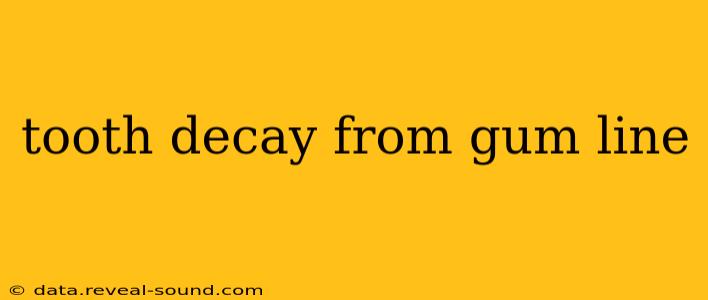Tooth decay, also known as dental caries, is a common problem that can affect teeth at any location, including the gum line. This type of decay can be particularly insidious because it’s often hidden from view and can progress rapidly. Understanding the causes, symptoms, and treatment options is crucial for maintaining good oral health.
What Causes Tooth Decay at the Gum Line?
Several factors contribute to tooth decay starting at the gum line. The primary culprit is bacteria. These bacteria feed on sugars and starches in food, producing acids that attack tooth enamel. At the gum line, several conditions make teeth particularly vulnerable:
- Plaque Buildup: Plaque, a sticky film of bacteria, readily accumulates along the gum line. This is because saliva flow is reduced in this area, making it a prime breeding ground for bacteria.
- Receding Gums: As gums recede, more of the tooth root becomes exposed. Root surfaces are less protected than enamel, making them more susceptible to decay. Receding gums are often associated with gum disease (gingivitis and periodontitis).
- Poor Oral Hygiene: Insufficient brushing and flossing allow plaque to accumulate, increasing the risk of decay, especially at the gum line where bristles and floss may not reach effectively.
- Dietary Habits: Frequent consumption of sugary drinks and snacks provides a constant source of food for the decay-causing bacteria.
- Dry Mouth: Reduced saliva production can decrease the mouth's natural cleansing ability, making it harder to wash away food particles and neutralize acids.
- Certain Medications: Some medications have side effects that can cause dry mouth, increasing susceptibility to decay.
What are the Symptoms of Tooth Decay at the Gum Line?
Early-stage decay at the gum line often presents without noticeable symptoms. However, as the decay progresses, you may experience:
- Sensitivity to Hot and Cold: This is a common sign of tooth decay, as the exposed dentin is more sensitive than enamel.
- Discoloration: The affected area may appear darker or stained.
- Pain: As the decay deepens, you may feel pain, especially when chewing or biting.
- Bad Breath: Decaying tooth material can contribute to persistent bad breath (halitosis).
- Visible Cavity: In advanced cases, a visible hole or cavity may be present near the gum line.
How is Tooth Decay at the Gum Line Treated?
Treatment depends on the severity of the decay:
- Fluoride Treatment: For early-stage decay, your dentist may recommend fluoride treatments to strengthen enamel and help remineralize the affected area.
- Fillings: If the decay has progressed into the tooth's structure, a filling is usually necessary to remove the decayed portion and restore the tooth's shape and function.
- Crowns: For extensive decay or severely weakened teeth, a crown (cap) may be needed to protect the tooth.
- Root Canal Treatment: In cases where the decay reaches the tooth's pulp (the soft tissue inside the tooth), a root canal may be required to remove the infected pulp and prevent further damage.
- Extraction: In severe cases, the tooth might need to be extracted if it is beyond repair.
Can Tooth Decay at the Gum Line be Prevented?
Yes! Practicing good oral hygiene is crucial in preventing tooth decay at the gum line:
- Brush Twice Daily: Use a soft-bristled toothbrush and fluoride toothpaste, paying special attention to the gum line.
- Floss Daily: Flossing removes plaque and food particles from between teeth and along the gum line.
- Regular Dental Checkups: Visit your dentist for regular checkups and cleanings to detect and treat decay early.
- Healthy Diet: Limit sugary and acidic foods and drinks.
- Maintain Good Gum Health: Address gum disease promptly as it increases the risk of decay at the gum line.
How do I know if I have gum recession?
Gum recession is often noticeable visually, as your gums appear to pull back from your teeth, exposing more of the tooth root. You may also experience sensitivity to temperature changes in the affected areas, or notice your teeth seem longer than before. Only a dentist can definitively diagnose gum recession.
Does tooth decay always hurt?
No, tooth decay does not always hurt, especially in its early stages. Early decay often goes unnoticed until it progresses and reaches the inner layers of the tooth, causing sensitivity or pain. This is why regular dental checkups are important for early detection.
What happens if tooth decay is left untreated?
Untreated tooth decay can lead to several serious complications, including:
- Severe toothache: The pain can become intense and debilitating.
- Abscess: A pus-filled pocket can form at the root of the tooth, causing swelling and severe pain.
- Bone loss: Advanced decay can damage the jawbone supporting the tooth.
- Tooth loss: Untreated decay ultimately leads to tooth loss.
By understanding the causes, symptoms, and treatment options for tooth decay at the gum line, and by practicing good oral hygiene, you can significantly reduce your risk and maintain a healthy, beautiful smile. Regular visits to your dentist are essential for early detection and prevention. Remember, prevention is always better than cure when it comes to your oral health.
